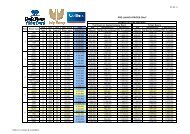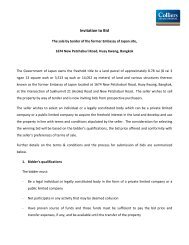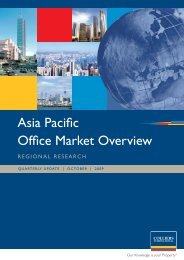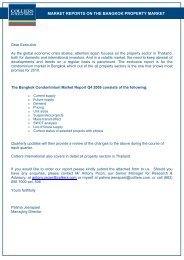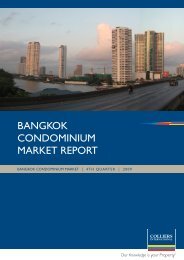CUBIC CoverDec08.indd - Colliers
CUBIC CoverDec08.indd - Colliers
CUBIC CoverDec08.indd - Colliers
Create successful ePaper yourself
Turn your PDF publications into a flip-book with our unique Google optimized e-Paper software.
Another example is the Wuhan Tiandi project, a registered LEED<br />
Neighbourhood Development (ND) pilot project in Hankou, along the<br />
Yangtze riverfront, comprising residential, office, hotel, retail, F&B and<br />
entertainment facilities.<br />
Employing an intelligent orientation to optimise access to wind and light<br />
while lowering sun exposure, the development also features district-wide<br />
centralised heating and cooling, water source heat pumps, rainwater collection<br />
and recycling facilities, and is poised to attain a LEED-ND Gold rating.<br />
Apart from just building physical structures, Shui On Land also operates<br />
and manages its buildings. “By being energy-saving and water-efficient, we can<br />
achieve long-term gains in the entire life span of the building,” said Nieh.<br />
This in turn adds to the value of the development. “The idea is to tie<br />
sustainability to a solid economic agenda,” said Nieh. “In the end, we are<br />
a business and need to be commercially viable. We believe our model is<br />
commercially viable and it makes a lot of sense.”<br />
It also helps that Shui On Land is riding on an overall thrust by the central<br />
Chinese government. “The government believes that, if they do not start<br />
embracing sustainability, they will eventually lose out on the gains and<br />
competitive edge that have been made in the past two decades,” said Nieh.<br />
That other Asian powerhouse, India, is also seeing green take root in the<br />
real estate sector. The Indian Green Building Council has recorded that, in<br />
2008, there were some 239 green building projects that made up a total of<br />
about 147 million square feet.<br />
According to an Indian Realty News (IRN) report, the growing environmental<br />
consciousness among MNC tenants is redefining the way buildings are being<br />
marketed. Increasingly, requests for proposals include questions about a<br />
building’s green quotient, a fact echoed by K Raheja Associate Vice-President<br />
Shabbir Kanchwala, who told IRN: “Many of our customers are Fortune 500<br />
companies that understand and prefer green buildings.”<br />
GROWING IN THE RIGHT DIRECTION<br />
There may still be some reticence among developers about wholly<br />
embracing sustainable building, given the higher financial outlay and<br />
effort, but greening offers much greater rewards in the long term, the most<br />
obvious being savings on energy and water.<br />
Based on developers’ feedback, green strategies comprise 2 to 10 per<br />
cent of a project’s total cost. But innovative forethought on passive design<br />
elements such as ventilation, use of materials and building layout can reap<br />
green benefits – with little or no cost.<br />
“Developers who approach going green as an opportunity to rethink<br />
how they produce buildings often find that such innovation helps them find<br />
cost savings in other places,” said Carter. “On the other hand, developers<br />
12<br />
January 2009 |





